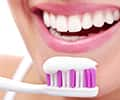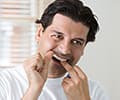Orange Juice and Toothpaste: Understanding the Taste Combo
The taste buds on your tongue play a big role in determining how foods, drinks, and toothpaste will taste. And how they'll taste in combination with each other. Besides your tongue, other parts of your head and throat are instrumental in your ability to taste. These include your:
- Roof of your mouth (soft palate)
- Cheeks
- Nasal cavity
- Epiglottis (throat flap that aids in breathing and preventing food from going down your windpipe)
- Back of your throat
With your taste receptors, you're able to detect five different flavor types:
- Salty
- Savory (sometimes called Umani)
- Sour
- Sweet
- Bitter
When orange juice and toothpaste get together, they affect your body's ability to taste sweet and bitter flavors. And that plays a big part in making your morning OJ taste so gross.
Meet Sodium Laurel Sulfate
If you read the ingredients on numerous tubes of toothpaste, you'll find most contain sodium laurel sulfate. Sodium lauryl sulfate (SLS) is a surfactant – or a type of soap. It's found in many beauty and household products, not just toothpaste. SLS creates suds or foam while you brush and helps clean your teeth.
SLS does two things that can transform OJ from a sweet, refreshing drink into a glass of bitterness:
- Suppresses the receptors on the taste buds that can pick up on sweet flavors. So, for a while at least, you're not able to taste "sweet" no matter what you drink.
- Breaks up phospholipids, the fatty compounds that help reduce bitter tastes. By blocking the receptors that sense bitterness.
OJ and other citrus juices usually have a mixture of bitter and sweet flavors. Under normal circumstances, you're able to taste the sweetness. But when your sweetness receptors are out of commission – and there's nothing to block your bitterness receptors – you're going to get a mouthful of blech.
I Love OJ and Must Brush My Teeth: What Can I Do?
To avoid the unpleasant taste of orange juice and toothpaste:
Eat and drink first, then brush your teeth. Just keep in mind that you should wait about 60 minutes after eating/drinking any citrus foods before brushing to avoid damaging your teeth's enamel.
Eating, waiting for 60 minutes, then brushing might shake up your morning routine, but the upsides are:
- It'll feel good not having "breakfast teeth" the rest of the day.
- You'll get OJ's plaque-causing acid and sugar off your teeth sooner than if you waited until your next brushing, which usually occurs at the end of the day.
You also might drink a glass of water during those 60 minutes to further ensure you won't damage your enamel when brushing after consuming citrus.
Switch to a toothpaste that doesn't contain SLS. If you aren't sure which toothpaste to use, you can always talk to your dental professionals to see what they recommend.
One tip: Many kinds of toothpaste for sensitive teeth are SLS-free.
Many taste combinations that seem yucky to some might appeal to others – chocolate and potato chips, anyone? But unless you adore a truly harsh taste in your mouth, toothpaste with SLS and orange juice won't do. We've given you solutions for solving your morning problem. Now it's up to you to banish the bitter and savor the sweet!
This article is intended to promote understanding of and knowledge about general oral health topics. It is not intended to be a substitute for professional advice, diagnosis or treatment. Always seek the advice of your dentist or other qualified healthcare provider with any questions you may have regarding a medical condition or treatment.
ORAL HEALTH QUIZ
What's behind your smile?
Take our Oral Health assessment to get the most from your oral care routine
ORAL HEALTH QUIZ
What's behind your smile?
Take our Oral Health assessment to get the most from your oral care routine
Join Us
Get the best of your oral health routine and take it to the next level with expert advice, recommendations, products and solutions and special offers.
Join Us
Get the best of your oral health routine and take it to the next level with expert advice, recommendations, products and solutions and special offers.















